Viktor Schütze | |
|---|---|
 | |
| Born | 16 February 1906 Flensburg |
| Died | 23 September 1950 (aged 44) Frankfurt am Main |
| Allegiance | |
| Service/ | |
| Years of service | 1925–45 |
| Rank | |
| Commands held | U-19 U-11 |
| Battles/wars | Battle of the Atlantic |
| Awards | Knight's Cross of the Iron Cross |
Viktor Schütze (16 February 1906 – 23 September 1950) was a German U-boat commander during World War II. He was a recipient of the Knight's Cross of the Iron Cross with Oak Leaves of Nazi Germany.
Schütze was born in Flensburg, and started his naval career in the Reichsmarine aboard German torpedo boats in April 1925, before transferring to the new U-boat division ten years later in October 1935. There he commanded U-19 for two years, before being relieved to take destroyer training - before returning to the U-boat arm in command of U-11. When war broke out he commanded U-25, with which he sailed on three patrols, mainly in the Bay of Biscay and off the Portuguese coast.
In July 1940 he assumed command over the Type IXB U-103, and commanded for four patrols in North Atlantic and African waters. In December he received the Knight's Cross of the Iron Cross for his successes. In August 1941 he retired from front service, taking up positions as Flottillenchef of 2nd U-boat Flotilla. In March 1943 he became the FdU Ausbildungsflottillen (Commander of the training flotillas in the Baltic Sea) in Flensburg-Kappeln, in which position he served until the end of the war. He died in Frankfurt am Main in 1950.
Awards
- Spanisches Marineverdienstkreuz, I. Class in white (21 August 1939)[1]
- Iron Cross (1939) 2nd Class (13 November 1939) & 1st Class (21 February 1940)[1]
- Italienisches Kriegskreuz with swords (1 November 1941)[1]
- Knight's Cross of the Iron Cross with Oak Leaves
- Knight's Cross on 11 December 1940 as Korvettenkapitän and commander of U-103[2][3]
- Oak Leaves on 14 July 1941 as Korvettenkapitän and commander of U-103[2][4]
- War Merit Cross with swords, 2nd Class (30 January 1944) & 1st Class (1 September 1944)[1]
References
Citations
- 1 2 3 4 Busch & Röll 2003, p. 99.
- 1 2 Scherzer 2007, p. 688.
- ↑ Fellgiebel 2000, p. 391.
- ↑ Fellgiebel 2000, p. 55.
Bibliography
- Busch, Rainer; Röll, Hans-Joachim (2003). Der U-Boot-Krieg 1939–1945 — Die Ritterkreuzträger der U-Boot-Waffe von September 1939 bis Mai 1945 [The U-Boat War 1939–1945 — The Knight's Cross Bearers of the U-Boat Force from September 1939 to May 1945] (in German). Hamburg, Berlin, Bonn Germany: Verlag E.S. Mittler & Sohn. ISBN 978-3-8132-0515-2.
- Fellgiebel, Walther-Peer (2000) [1986]. Die Träger des Ritterkreuzes des Eisernen Kreuzes 1939–1945 — Die Inhaber der höchsten Auszeichnung des Zweiten Weltkrieges aller Wehrmachtteile [The Bearers of the Knight's Cross of the Iron Cross 1939–1945 — The Owners of the Highest Award of the Second World War of all Wehrmacht Branches] (in German). Friedberg, Germany: Podzun-Pallas. ISBN 978-3-7909-0284-6.
- Scherzer, Veit (2007). Die Ritterkreuzträger 1939–1945 Die Inhaber des Ritterkreuzes des Eisernen Kreuzes 1939 von Heer, Luftwaffe, Kriegsmarine, Waffen-SS, Volkssturm sowie mit Deutschland verbündeter Streitkräfte nach den Unterlagen des Bundesarchives [The Knight's Cross Bearers 1939–1945 The Holders of the Knight's Cross of the Iron Cross 1939 by Army, Air Force, Navy, Waffen-SS, Volkssturm and Allied Forces with Germany According to the Documents of the Federal Archives] (in German). Jena, Germany: Scherzers Militaer-Verlag. ISBN 978-3-938845-17-2.